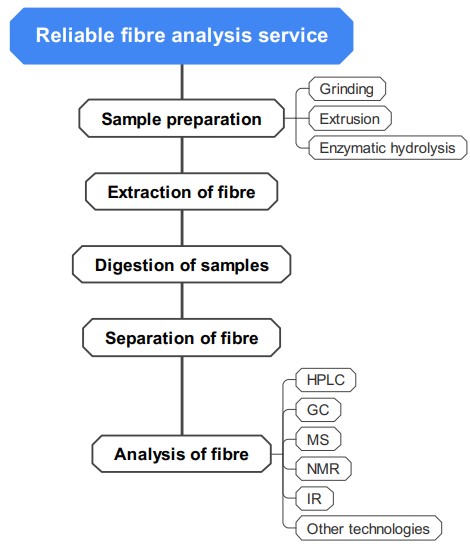Fibre Analysis Service
Services Published Data FAQs Customer Review
Reliable Fiber Analysis Service at Creative Biolabs
Fiber is a polysaccharide composed of a variety of polymers, which is often applied in the food industry because of its unique functional properties, safety, and green features. Common dietary fiber polysaccharides include cellulose, hemicellulose, and pectin, which are composed of different monosaccharide units. Specifically, cellulose is composed of glucose units, hemicellulose is composed of monosaccharide units such as glucose, xylose, and mannose, while pectin is composed of monosaccharide units such as galactose, galactomannose, and galacturonic acid. These fiber polysaccharides are the main components of most plant cell walls, and they play a vital role in food, especially in human digestion and health. Therefore, providing fiber analysis services can obtain the type, content, and structure information of fiber polysaccharides in samples, providing important data references for food quality assessment, nutritional value research, etc.
Creative Biolabs has a mature Carbohydrate Analysis Platform, and we provide a variety of Polysaccharide Analysis services, including Heparan Sulfate, 3-O-Sulfation Analysis, and fiber analysis services.
-
Sample preparation
We perform appropriate sample preparation processes, such as grinding, extrusion or enzymatic hydrolysis, etc., to obtain analyzable fiber polysaccharides.
-
Extraction of fiber
We place the above samples in appropriate solvents (such as methanol, ethanol, etc.) for extraction in order to separate the target fiber from the sample matrix.
-
Digestion of samples
The dissociation of polysaccharides into measurable oligosaccharides is the prerequisite for polysaccharide analysis. Reliable digestion ways are the key to polysaccharide analysis. We digest the extracted fiber to digest non-fiber polysaccharide components and simultaneously degrade the fiber into monosaccharides or oligosaccharides.
-
Separation of fiber
We perform centrifugation, filtration, and other steps on the sample to remove impurities and ensure that the sample to be tested is an extract of fiber.
-
Analysis of fiber
We use chromatography (such as high-performance liquid chromatography (HPLC), gas chromatography(GC)), mass spectrometry (MS), nuclear magnetic resonance spectroscopy (NMR), infrared spectroscopy (IR), and other technologies to conduct a comprehensive analysis of the structure and content of fiber to ensure the accuracy and reliability of the analysis results.

Published data
Enzymatic treatment of cellulose fibers is a traditional chemical modification scheme. Lytic polysaccharide monooxygenases (LPMOs) are a new class of enzymes that, when acting on cellulose, can cause chain breakage and oxidation at the C1 or C4 position, thereby changing the structural integrity of the fiber and introducing new oxidative functions on the fiber surface to regulate the properties of cellulose fibers. In this study, the authors developed a reliable analysis method to evaluate the oxidation sites on cellulose fibers and the changes that occur when LPMO treats cellulose substrates. This method was based on the quantification of fluorescent labels and was combined with size exclusion chromatography (SEC) for analysis. This analytical technique was an effective way to gain an in-depth understanding of the catalytic effects of LPMOs.
 Fig.1 Schematic diagram of LPMO enzyme acting on cellulose.1
Fig.1 Schematic diagram of LPMO enzyme acting on cellulose.1
Advantages
-
Advanced instruments: We are equipped with advanced instruments to provide high-quality fiber analysis services to ensure the accuracy and reliability of analysis data.
-
Diversified analysis technologies: We have a professional analysis team who master a variety of analysis technologies, such as HPLC, GC, MS, etc., and provide clients with high-level fiber analysis services.
-
Data visualization: We provide intuitive and clear fiber analysis reports and visual charts to facilitate clients' understanding and application.
Application
-
Food: Fiber analysis can help determine the fiber content in food products, which is important for manufacturing high-fiber foods and conducting food nutritional assessments.
-
Healthcare: Fiber analysis is used to evaluate the healthy fiber content in different products, which can be very helpful in studying the diet of patients with cardiovascular disease, digestive problems, and other chronic diseases.
-
Agriculture and environmental sciences: Fiber analysis is used to evaluate fiber content in different agricultural products or soils, aiding in soil improvement, plant growth, and environmental health assessments.
Creative Biolabs has highly specialized and experienced analysis technology teams, whose rich analysis experience can ensure the best service quality and data accuracy for our clients. We respond quickly to client needs and provide efficient fiber analysis services and fast analysis results. Please feel free to contact us if you would like to get specific content.
FAQ
Q1: What aspects does the fiber analysis service you provide cover?
A1: Our fiber analysis service covers fiber composition analysis, structural analysis, property evaluation, etc. to ensure a comprehensive understanding of the characteristics of the sample.
Q2: What is your analysis cycle?
A2: The analysis cycle will vary depending on the type and quantity of the sample and the complexity of the analysis method. It generally takes several working days to several weeks from the receipt of the sample to the completion of the analysis report.
Customer Review
Excellent Analytical Team
“The analytical team at Creative Biolabs performed well. They had extensive expertise and answered all our technical questions. They were very professional! The fiber analysis results they provided were very accurate, which played an important role in promoting our research.”
Fast Response Time
“The time from submitting samples to receiving analytical results was very quick, especially in urgent situations. Creative Biolabs was able to handle it quickly, allowing us to make production decisions promptly. Even after receiving the report, they were still willing to provide follow-up technical support to help us further understand the data.”
Reference
-
Sulaeva, Irina, et al. "A novel approach to analyze the impact of lytic polysaccharide monooxygenases (LPMOs) on cellulosic fibres." Carbohydrate Polymers 328 (2024): 121696. Distributed under Open Access license CC BY 4.0, without modification.
For Research Use Only.
Related Services


 Fig.1 Schematic diagram of LPMO enzyme acting on cellulose.1
Fig.1 Schematic diagram of LPMO enzyme acting on cellulose.1

